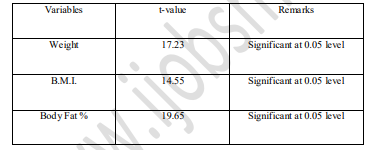A COMPARATIVE STUDY OF BODY COMPOSITION AND RELATIVE HEALTH STATUS AMONG RESIDENT AND NON-RESIDENT STUDENTS IN DIFFERENT SCHOOLS OF J&K
Keywords:
Residential, Non-Residential, Body Comnposition and Nutritional Status.Abstract
The purposes of the study were to find out body composition and relative health status of the resident and nonresident students in different schools of J&K and their comparison with each other. A total of 100 resident students in different schools of J&K and 10 non-resident students in different schools of J&K in between the age of 15 to 19 years were selected randomly from different resident and non-resident schools in the jammu region of J&K and comparison was done between these two groups. Height, Body weight, body fat percentage and body mass index were considered as variables for measurement of health and nutritional status in the investigation. All the variables were measured with the standard tools and equations. Mean and Standard deviation were calculated as descriptive statistics and to find out the inter group difference t-test was conducted. Result shows those resident students groups were superior in weight, PBF and BMI than non-resident students. Result also revealed that resident students group was in over weight zone in respect of BMI but non- resident students group was in the normal zone in this category. All the mean difference between these two groups was found statistically significant in this study
Metrics
References
Bandyopadhyay, N. (2007), “Studies on elderly women on their sedentary life style and on being active” Ph.D. Thesis, University of Kalyani, West Bengal.
Blair, S.N. et al. (1981). Interactions among dietary patter, physical activity and skin fold thickness, Research quarterly, 52 (4):777-782.
Chaine et al. (1989). Body mass index is a discriminate function among health-related variables and risk factors. J. Sports Med phys Fitness; 29(3):253-61
Joshi, A.R. Singh, R. and Joshi, A.R. (2008), Correlation of pulmonary function tests with body fat percentage in young individuals, Indian J. Phsiol Pharmacol, (52 (4), 383- 388.
Koley, S. Kaur,N and Sandhu, J.S. (2009). A Study on hand grip strength in female labourer of Jalandhar, Punjab, India, J Life Sci, 1 (1): 57-62.
McArdle, W.D. Katch, F.I. and Katch, V.L. (1996), Exercise physiology: Exercise, Nutrition and Human performance, Lea and Febiger: Balthinore (4th Ed).
Misra, K.B. Endemann, S.W. and Ayer, M. (2005), Leisure time physical activity and metabolic syndrome in Asian Indian Immigrants residing in Northern California. Ethnicity and Disease, Vol.15:625-634.
Saha Roy, G. (2010), Effect of Aerobic Training Programme on Active and Moderate Active NIDDM Female, Ph.D Thesis, Depart of Physical Education, University of Kalyani, West Bengal, India.
Tahara, Y. Moji, K. Aoyagi, K. Tsunawake, N. Murake, S. and Mascie-Taylor, C.G. (2016), Age related pattern of body density and body composition of Japanese men and women 18-59 years of age. National Institution of health, Am J Hum Biol, Vol. 14(6):743-52.
Upadhyay, S. Kumar, A.R. Singh, R. R. and Singh, B.B. (2011), Nutritional Status and Knowledge of Hill Women on Anemia: Effect of Various Socio-demographic Factors, J Hum Ecol, 33 (1): 29-34.
WHO (World Health Organization), 2016; http://apps.who.int/bmi/index
Wimberley, M.G. Milinda, M.M. Cathlin, W. Pamela, D.S. and Steven, S.C. (2016), Effects of habitual physical activity on the resting metabolic rates and body composition of women aged 35 to 50 years. J Am Diet Assoc. 100:1181-1188.











